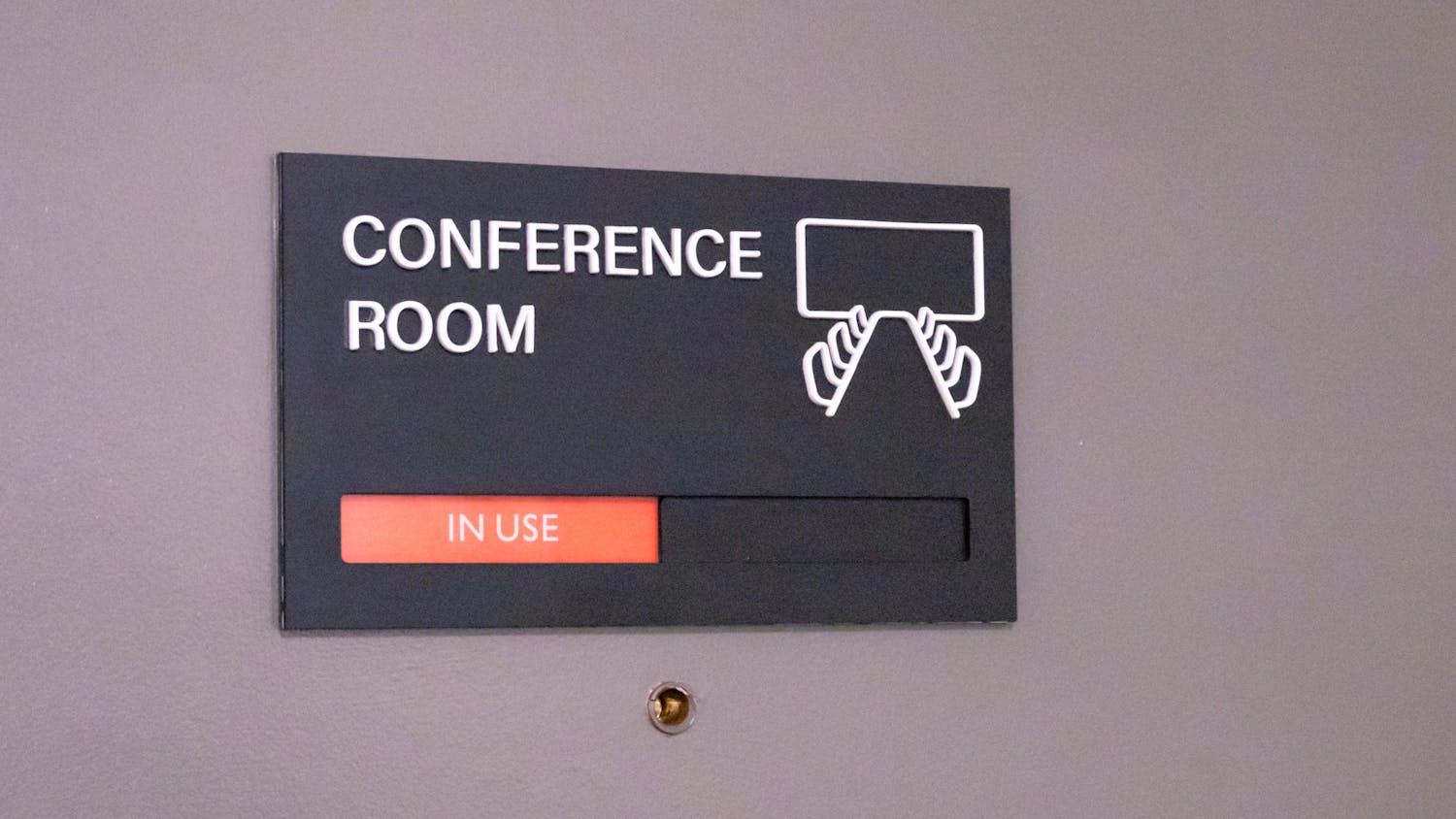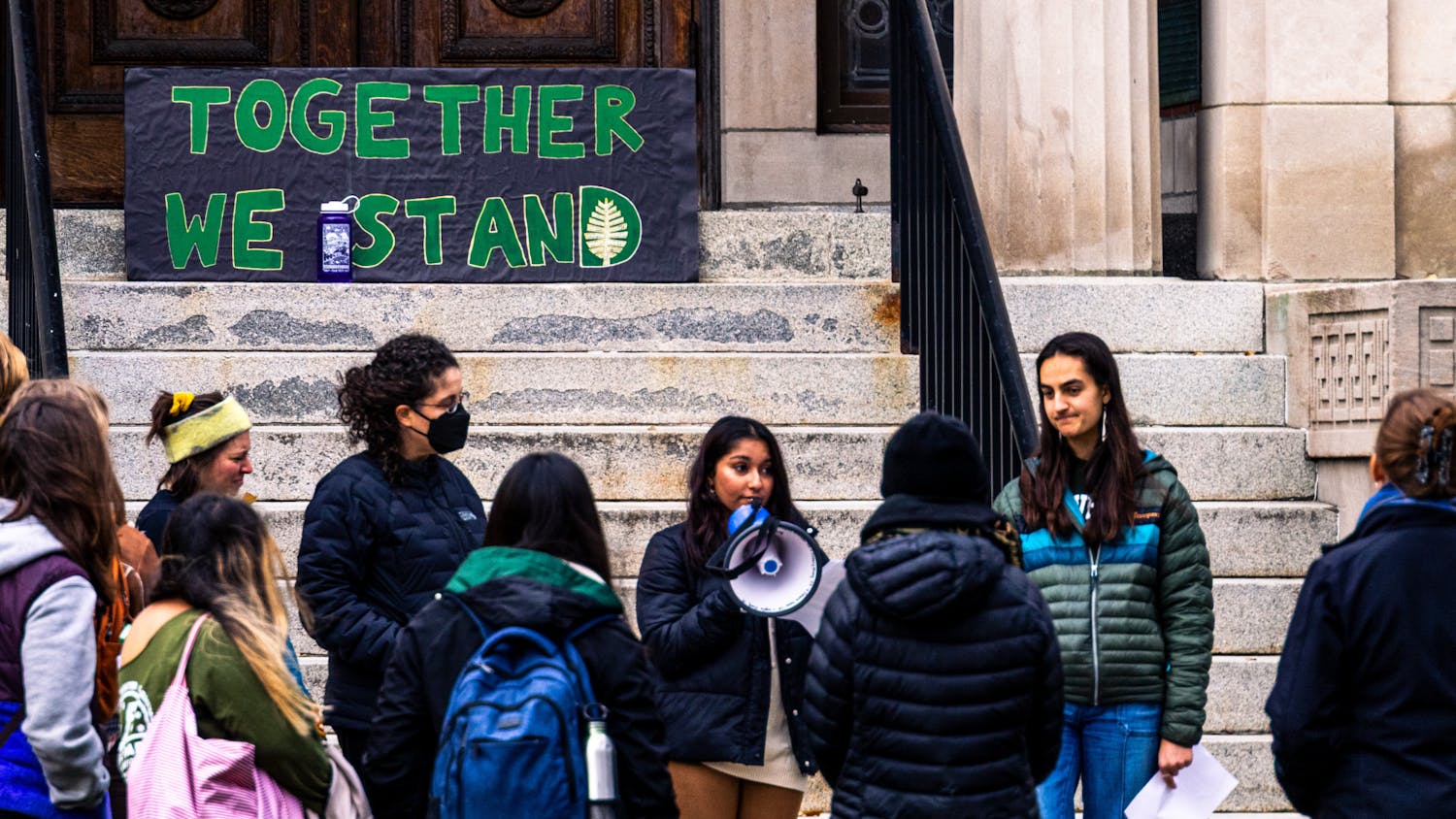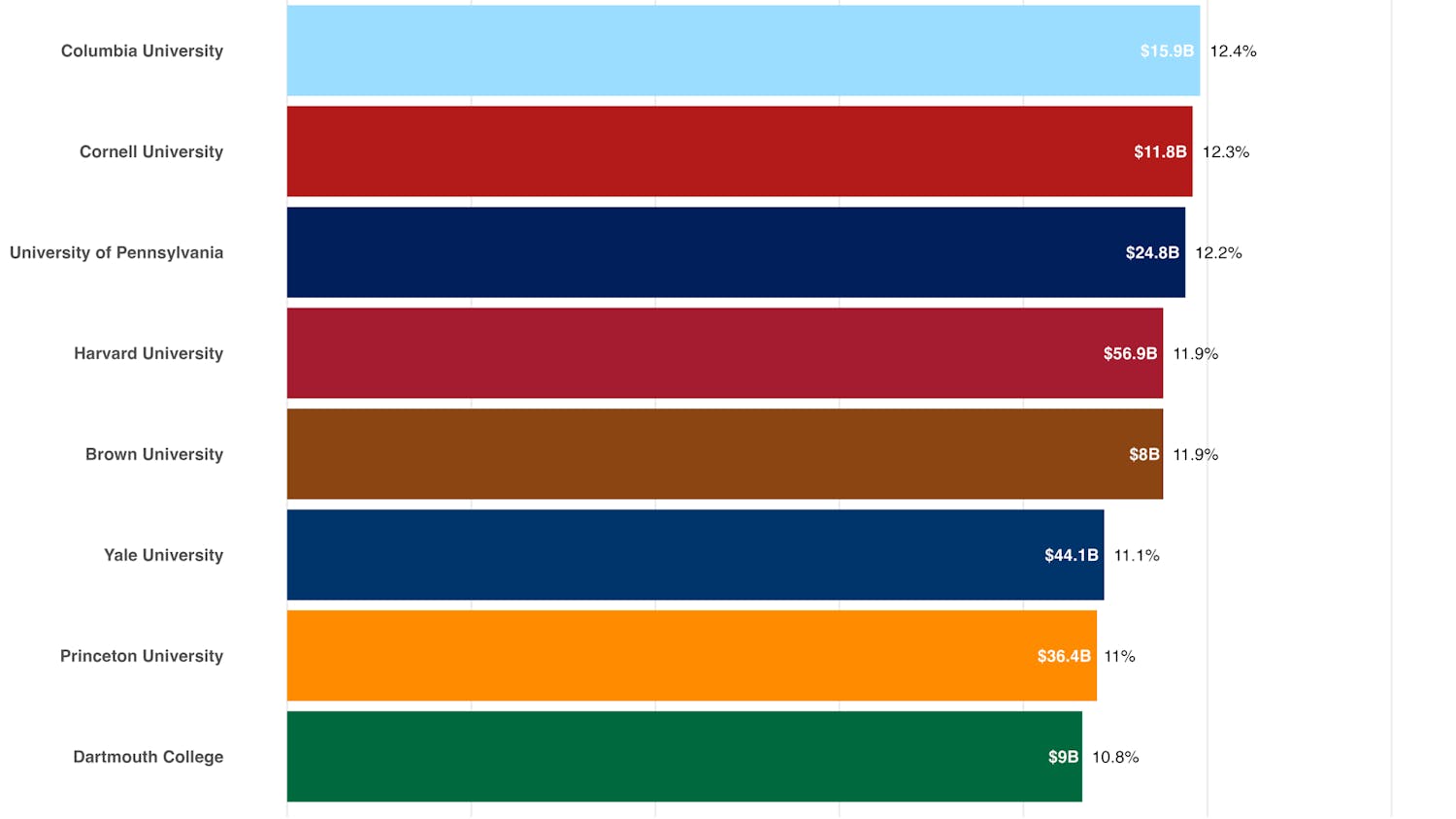When she was a high school student visiting college campuses, Tina Bria '01 noticed something odd about the 1902 Room in Dartmouth's Baker Library.
Although the College had been coeducational since 1972 and half of the kids studying in the room were female, the room's atmosphere was distinctly masculine. Of the 14 portraits on the wall, not one portrayed a woman.
"I kind of expected it," Bria said. "I'd heard so much about this place as a guy school, a place for male jocks."
This year Dartmouth celebrates 25 years of coeducation. But for 203 years, the College was a bastion of young manhood. Some people believe that hasn't changed all that much.
During the 1990s, the College finally achieved gender parity in the student body, and social and academic support systems for women flourished. But men still control the social space and the upper echelons of the administration, and men far outnumber women on the faculty.
In 1977, College Vice President Ruth Adams called Dartmouth "a college for men that admits women." In 1997, it is useful to ask whether Dartmouth is truly coeducational.
The College gets an education
In the 1990s, the percentage of women in the student body neared 50 percent, leading many to believe that the fight for gender equity would at long last come to an end. But throughout the last seven years, women have strived to combat complacency among their classmates.
Even though the College seemed fully coeducational, sexism lurked in subtle places. An opinion piece in The Dartmouth in 1991 derided a sexist pinball game in the Topside arcade.
The object of the game was "to turn the cold, lifeless female shaped android into a 'real' woman, through various manipulations of the pinball ... if you reach a billion points, you succeed in giving this frigid robot-turned-sexy-momma the cybernetic orgasm of her life," it stated.
But the virtual sexism in the arcade was almost trivial compared with the lingering problem of sexual abuse. The College reevaluated its treatment of abuse cases in 1992, following a wave of sexual assault complaints.
One incident in March of 1992, in which a woman was sexually assaulted in her dorm room, caused an uproar among students and administrators. Safety and Security stepped up the number of officers patrolling campus on foot, and made student escorts more readily available.
Six days after the assault, 200 students held a candlelight vigil on the Green to show their support for the woman. At the vigil, one woman urged the crowd not to let their support for victims of sexual assault slip when the outrage subsides.
"You've stepped forward and said 'I care!' Don't let it end," she said.
Fraternity members answered the call and formed the student group "Greeks Against Rape" to show solidarity with the woman who filed the complaint and for other victims of sexual assault.
"Just because someone is anti-sexual assault doesn't mean he has to be anti-Greek as well," one of the group's founders told The Dartmouth in 1992.
The assaults prompted the creation of a men's discussion group to work through the defensiveness some men felt about sexual assault. "We hope to discuss issues of gender relations, sexuality and sexual assault as well as other issues that men might not ordinarily discuss with other men, either because they're too threatened or embarrassed or even uncertain," said one group member in 1993.
For the first time, students were trained as Sexual Abuse Peer Advisors, and Collis Miniversity's Self Defense and Rape Prevention program was granted physical education credit.
At the same time as students struggled to inform their classmates about sexual assault, others were educating the campus about eating disorders.
The organization SAFE, Students Against the Abuse of Food and Exercise, conducted surveys to learn more about women's eating habits and body image and sponsored lectures to increase the campus' awareness of eating disorders.
Students think "you have to be perfect to succeed here, perfect in everything: intellectually, socially, appearance, body, hair, hips," one member of SAFE told The Dartmouth in 1992.
But that was not the only kind of pressure felt by the women of Dartmouth.
Discrimination is commonplace
In a 1991 poll, 40 percent of female students said they had experienced discrimination at the hands of their male peers.
To combat discrimination, a number of organizations and support groups were formed by and for women. Their creation and methods, however, sparked debate among the campus' men and women.
A support group for women of color gained prominence in 1993 as a place where minority women could vent their feelings and concerns without inhibitions. But the group was criticized by white women who thought it was exclusionist.
The Untamed Shrews, a feminist performance group, sparked controversy at a guerrilla performance in Thayer Dining Hall in 1993. At noon on a weekday, one student shouted from the balcony overlooking Food Court, "If God had meant women to give blowjobs, she wouldn't have given us teeth." Then she bit off the end of a cucumber and spit it over the railing.
Next, eight members of the group read a poem about a woman who altered her looks to please a man and ended with the words, "Hey you, f*ck off."
One male student said he was offended by the group's use of language. "It's not exactly the kind of thing I wanted to hear at lunch," he said. "I understood the message they were trying to convey, but did not agree with the way they did it."
The manager of Food Court asked the group not to use profanity in future performances and to provide a script before their next Food Court appearance.
A group of ten students plastered "Womyn are everywhere" stickers all around campus. One student complained after the group placed a sticker on his car's bumper.
Playboy redux
A photographer for Playboy magazine returned to Hanover in 1995 to find students to pose naked in the "Women of the Ivy League" spread, but his reception was even more frigid than in the 1980s.
While a few women bared their breasts at a pre-shoot in the Hanover Inn, 35 of their classmates marched around the Green and rallied in the Hop in protest. Protesters chanted "Hey hey, ho ho, Playboy has got to go" and held up signs declaring, "Playboy = degradation."
Many women, however, were excited by the opportunity to pose in the magazine. Nakiah Cherry '96, who participated in the pre-shoot but missed the magazine shoot because of a history class field trip, said she was at ease posing for the magazine's photographer.
"My breasts were falling out here and there and [the photographer] was a professional," she said in an interview with The Dartmouth last week. "I didn't feel like he was trying to molest me." But Cherry said Playboy's price, between $500 and $600, was a little low.
"It's not that much compared to the amount they should be paying to see me naked," Cherry said.
But the controversy faded quickly, and when the "Women of the Ivy League" hit the shelves later that year -- featuring two topless Dartmouth students -- it sold like hotcakes.
Women today
Women have continued to progress towards equality in the 25 years since coeducation, but they recognize that a quarter-century of integration cannot erase an all-male past. The most notable example of gender inequity in many students' minds is the Greek system, where fraternities far outnumber sororities.
"Most social space is male dominated," said Matthew Brennan '98. "Women have their own space, but most of the functions are on male turf."
There are 16 fraternities, but only nine sororities, and most of the women's houses are prohibited from holding parties with alcohol.
Cherry said women's presence on male "turf" gives men a sense of control over their female guests. "A lot of guys power trip," she said.
Many women contend that the fraternity scene can be a breeding ground for sexual assault. Susan Marine, the Sexual Abuse Awareness Program coordinator, said sexual assault is a problem at Dartmouth because it is a problem in society at large.
"Dartmouth is a male place," Marine said. "It probably does contribute to sexual assault happening here. But the incidence and the way it is handled isn't worse. It's always a problematic thing."
Marisa Howe '98, the program intern, agreed that Dartmouth's male-dominated social scene is as much a product of society as it is of College life.
"It's kind of how schools are structured," she said. "It's kind of hard for a school not to have a male presence."
But there are many alternatives to the male-dominated Greek scene.
"Fraternities play a big role in campus life, but there are many places where men and women can get together," said Dave McCarthy '99. "There are a lot of people, both men and women, who tend to stay away from the Greek system."
McCarthy mentioned cultural nights, concerts, movies and lectures as alternatives to fraternities.
The issue of women's space is not, however, limited to social space. Some women feel that the Women's Resource Center, located in faculty apartments adjacent to the Choates, should be given a more visible campus location.
"Space is a very difficult issue," said Giavanna Munafo. "Academic programs have a priority, but offices like the women's center are integral to our academic mission and perhaps should be looked at more carefully."
"Were the Women's Resource Center to be an extremely high priority, it would be in an extremely prominent location," said the center's intern, Corey Chatis '98. "We could have a much better space, but I don't feel like we've been pushed off into a corner."
In the classroom
Women have made vast strides toward equity in academics, but some say men still control the classrooms, both as professors and as students.
Dartmouth has a higher percentage of tenured female faculty members -- 17.6 percent -- than any other school in the Ivy League, but the College has hardly reached parity. As of July, 1996, only 29.8 percent of the total number of professors -- tenured or non-tenured -- are women, and in many departments female professors are almost non-existent.
While 13 of the 33 tenure-track or tenured faculty in the English department were female in 1996, only one tenured or tenure-track professor in the physics department was a woman.
Three of the 24 faculty at the Thayer School of Engineering in 1996 were female, and none of those women were full professors.
Joe Hyland '01 said the number of male professors in College classrooms is an indication that Dartmouth remains a male-oriented institution. "All my professors are male. I'd have to say" women are not equal on campus, he said.
As a result, women as students might face a disadvantage in the classroom.
Studies have shown teachers call on men more frequently than women, and that "they react more positively to the responses of men, including coaching their answers," according to "Achieving Gender Equity in Science Classrooms," an instructional guide for professors.
But Mary Pavone, the director of the Women in Science Program, said some faculty can overcompensate for this discrepancy by singling out female students.
She pointed out that graduate students can be a source of potential discrimination because, unlike other colleges, Dartmouth trains very few of its teaching assistants.
Left to their own devices, these students often mimic the methods of their advisors and can unknowingly discriminate against female students.
WISP's presence has increased awareness of women's underrepresentation in the sciences, but, even after seven years of work the program has not achieved gender equity, Pavone said.
"Equity may not result in equal numbers of men and women in different careers," she said. "We're looking to create a learning environment that is equally inviting to women as it is to men."
Pavone also pointed out that the "traditional" teaching methods employed on introductory science classes provide an atmosphere were some, but not all, female and male students can learn.
"Women need connections. In general they understand things better when taught in context," Pavone said.
She said women can occasionally feel out of place in science classrooms.
Pavone said the Women in Science Project will evaluate whether attempts to education professors have been successful in raising teachers' consciousness during the next two years.
Despite an increase in the number of interested women pursuing science majors after arriving at the College, some students have been critical of the fact that WISP's intern program gives women special opportunities.
"Students here are all basically on the same intellectual level," said Heather Duckworth '98. "They should have the same help. It is really great for women, but I think men could gain from that experience as well."
But other students said the intern program's exclusion of men is appropriate.
"It's hard to do well in the sciences for women because they haven't been given as many chances," said Michael Koss '00. "Men have the leg up when it comes to jobs. There's really no reason for that."
Women's support groups
Women now have assumed leadership roles in many campus organizations, and the number of social alternatives has grown, but many students think all-female organizations are still a vital part of their lives at the College.
Emily Cullen '00 a member of the all-female Decibelles a cappella group, said most of her interactions with men occur in fraternity basements and are likely to be "on a more flirtatious level," and the women she meets in fraternities seldom become friends.
But the sorority system and the Decibelles have been instrumental in her experience, she said.
Untamed Shrews member Debbie Greenberger '00 said her organization still plays a vital role.
"We only do pieces by women writers. It's important to have those voices for women," Greenberger said. "We don't think about them that much."
The group structures its shows to attract new audiences to performances, Greenberger said.
"Often you preach to the converted. [By performing in areas like Food Court] you're exposing everyone who eats to ideas and you get a wider audience," she said.
Greenberger said last term's topic, "Female Sex" also attracted new blood to Shrews performances.
More to be done
The Class of 1999 was the first in the College's history to have as many women as men. Gender parity was a long time coming; gender equity may still be on the horizon.
Currently, College Vice President and Treasurer Lyn Hutton is the only senior level administrator who is a woman. The president, provost, dean of the College, dean of the faculty and the deans of the graduate schools are all men.
Female student leaders may be at a disadvantage compared to men. According to Dean of Student Life Holly Sateia, when a woman "wants to change the status quo or create change based on the perspectives and experiences they bring to the task, they are challenged or often criticized."
More work remains, but no one will question that Dartmouth has undergone immense changes during the past 25 years, as Trustees, alumni, administrators, faculty and students have struggled to make the College a school that welcomes women.
Dartmouth was a school for men for 203 years; for 25 years, it has been a school for both men and women. Coeducation occurred in 1972, but the story of coeducation will continue to be written for years to come.



